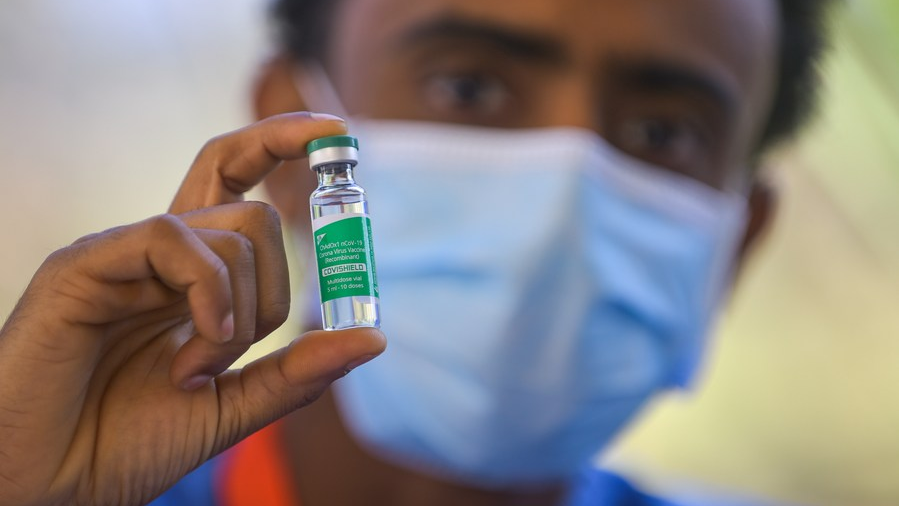
Editor's note: Decision Makers is a global platform for decision makers to share their insights on events shaping today's world. Justice Nonvignon is the Acting Head of the Health Economics Programme at the Africa Centers for Disease Control and Prevention (Africa CDC) and Nicaise Ndembi is the Senior Science Advisor to the Africa CDC Director. The article reflects the authors' opinions and not necessarily the views of CGTN.
The COVID-19 pandemic has forced governments in Africa and around the world to make difficult decisions that profoundly affect their populations' health. Many countries over-stretched their health workforce by redirecting limited resources towards COVID-19 response efforts, often at the expense of other deadly diseases. Access to routine immunizations, treatment and diagnostics needed to combat HIV/AIDS, tuberculosis and malaria were threatened because of supply-chain disruptions and resource constraints caused by COVID-19 containment measures.
Cumulatively, as of mid-June, over 580 million doses of COVID-19 vaccines have been administered on the continent. Of these doses administered, over 300 million people have been partially vaccinated, close to 250 million have been fully vaccinated, and slightly over 20 million have received a booster dose. Overall, approximately 17 percent of the continental population is fully vaccinated.
As African public health leaders focus on rebuilding health systems and programs and reversing the gains lost, they will also need to continue supporting COVID-19 vaccination to protect Africa's most vulnerable. Success will depend on taking the most cost-effective response that will quickly achieve greater health impact at least cost and will require the use of a formalized community healthcare worker structure, improved digital information systems and an integrated delivery system for healthcare.
We collected data from 27 African countries to model the cost-effectiveness of COVID-19 vaccination in Africa, including the hospitalizations averted, and lives saved compared to the cost of vaccine delivery through campaigns and clinic-based vaccination programs.
We examined when African countries initiated COVID-19 vaccine roll-out; the efficiency of ramping up the campaigns; the selected populations targeted for vaccination, and the types of vaccines used, which determine the number of doses required and needs for cold storage capacity. Our analysis from the 27 countries shows that the next phase of the fight against COVID-19 can be more effective if we follow three key strategies: be targeted, be fast and be frugal.
First, we must get back to basics regarding who needs COVID-19 vaccines at this point of the pandemic. Africa's population is on average younger and at lower risk of severe illness from COVID-19. We have also recently observed significant levels of natural immunity among Africans (more than 65 percent) as a result of a previous COVID-19 infection or receiving COVID-19 vaccines. At the same time, current evidence indicates that certain populations – the elderly, pregnant women, health workers and those with co-morbidities such as hypertension and diabetes – are at much greater risk of illness and death.
Although the initial recommendations focused on achieving high vaccination coverage across the total population, our study shows the value of being more targeted in our response efforts. In Kenya, for instance, our partners found that scaling up vaccines to 30 percent of the population – but focusing on the elderly – was considerably more effective in preventing more severe illness and hospitalization than trying to reach 70 percent of the general population. In Nigeria, we observed similar findings when modeling a scale-up plan targeted to those most at-risk (for severe COVID-19 disease) or approximately 25 percent of the population.

A medical worker shows a vial of the COVID-19 vaccine in Addis Ababa, Ethiopia, March 13, 2021. /Xinhua
A medical worker shows a vial of the COVID-19 vaccine in Addis Ababa, Ethiopia, March 13, 2021. /Xinhua
Second, we are still in a race against this disease, to protect the population against severe disease but also to prevent the emergence of potentially more virulent variants and sub-variants. In countries where large numbers of the populations remain unvaccinated, public health leaders must move with urgency and scale up more efficiently. In our analysis, vaccine efforts became less cost-effective, or not cost-effective at all, in countries delaying the scale-up of COVID-19 vaccine campaigns. In South Africa, another study found that 40 percent vaccine coverage achieved through a fast rollout provided greater health benefits over a year than a 67 percent rollout attained slowly.
To achieve effective COVID-19 vaccine coverage, additional investments targeting on-the-ground challenges will be needed. Most importantly, the Africa Centers for Disease Control and Prevention (Africa CDC) must support risk communication programs to help encourage Africans – especially those most at risk – to get vaccinated.
To be effective, risk communicators from the community and those who are well trusted should be identified and deployed to high-risk areas as being done by the Africa Union and the Africa CDC Bingwa Initiative which will partner with youth champions across the continent to accelerate the uptake of COVID-19 vaccination in Africa. We also urgently need to modernize our supply chains to improve COVID-19 vaccine access to populations in the provinces or rural areas.
Third, we must recognize that every plan comes with a cost. The effectiveness of most COVID-19 vaccines against severe illness does not vary significantly; but the price of the same vaccines varies considerably. To make vaccination programs as cost-effective as possible, countries may need to obtain vaccines at the lowest price possible. The goal is to be frugal about our vaccine purchases, without sacrificing quality.
A critical step on this path for Africa is self-sufficiency in the production of our own vaccines. Consider that less than 20 percent of people in low-income countries have received a dose of the COVID-19 vaccine, compared with about 80 percent in high-income countries. The disparity in access is unacceptable.
Within this context, the Africa CDC launched the Partnerships for African Vaccine Manufacturing (PAVM). The partnerships are both crucial and timely and deserve maximum support. The goal is to build vaccine production capacity such that by 2040, 60 percent of all vaccines used on the continent are produced in African countries. The partnerships are also contributing to bringing COVID-19 vaccine production to the continent. Over time, this will help ensure that Africa has reliable access to vaccines for COVID-19 (and other vaccine-preventable diseases) at reasonable prices.
We are confident that we can successfully vaccinate the populations in Africa at great risk of COVID-19 and reinvigorate our strained health systems. To do this, we must be guided by data-driven decision making and ensure that each decision we make is cost effective and impactful.
(If you want to contribute and have specific expertise, please contact us at opinions@cgtn.com. Follow @thouse_opinions on Twitter to discover the latest commentaries in the CGTN Opinion Section.)

